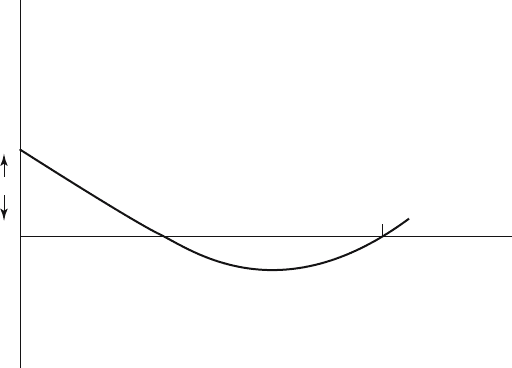Keyfitz N., Caswell H. Applied Mathematical Demography
Подождите немного. Документ загружается.

16.3. Three-Child Families Constitute a Population Explosion 425
has proven fruitful. Recent surveys have gone further and further in the
direction of integrating the underlying biological processes with their demo-
graphic consequences (Campbell and Wood 1994, Wood 1994, Wachter and
Bulatao 2003), including comparisons with some of our near but nonhuman
relatives (Altmann and Alberts 2003).
16.3 Why Three-Child Families Constitute
a Population Explosion, Whereas Two-Child
Families Would Lead to the Extinction
of Mankind
Let us see what three children mean for the growth of a population subject
to United States mortality. There are four steps in the calculation, which we
will carry out for females; the first three steps establish by how many fertile
women a woman past childbearing will be replaced in the next generation.
1. If fertile women surviving through childbearing average three children
in all, they will average 0.488 × 3 or 1.464 girls, the proportion of
United States, 1967, births that were girls being 0.488.
2. Not all of the girls will live to reproduce in turn. Again according to
data for the United States in 1967, the average fraction who survive
to childbearing, that is, the ratio of the net to the gross reproduction
rate, is 0.9665. By multiplying 0.9665 by 1.464 we go from gross to
net reproduction and find 0.9665 × 1.464 = 1.415 = R
0
.
3. An unknown fraction of girls are physiologically incapable of having
children or do not wish to have them; let us allow 10 percent to cover
these. This brings us to 1.415 × 0.9=1.273 as the number of fertile
women by which a fertile woman is replaced on the average.
4. The period over which this replacement ratio applies is one genera-
tion, or 26.14 years for 1967 in the United States, about the same
as the mean age of childbearing. We need the 26.14th root of the
replacement ratio 1.274 to obtain the annual ratio of increase:
1.274
1/26.14
=1.00931,
or, as an annual rate compounded momently, log 1.274/26.14 =
0.00926, either way an increase of 0.0093 or 0.93 percent.
Thus, with the assumptions here made, including that the ages of child-
bearing are the same as those of the United States in 1967, and that 10
percent of women do not have any children, a three-child average for fertile
couples implies an increase of 0.93 percent per year. This works out to a
doubling in 75 years, and a multiplication by 16 in less than 300 years. With
426 16. Microdemography
three-child families from now on the United States would have a population
of about 3 billion within three centuries.
On the other hand, an average of two children per fertile married woman
would not suffice to maintain the population. Calculation similar to that
above shows that the population would ultimately change in the ratio of
2 ×0.488 ×0.9665 ×0.9=0.849 per generation, or the 26.14th root of this,
0.9938 per year, which is a decline of 0.62 percent per year. The half-life
would be 111 years, and with two-child families to fertile women the United
States population would fall to 30 million in a little over three centuries.
Interpolation from the above will give the average that would hold the
population stationary. More directly, call the number x, and solve the
equation
x × 0.488 × 0.9665 × 0.9=1.
The result is 2.36 children per fertile married women, In summary, with
present United States death rates an average of three children leads to a
population of more than 3 billion in three centuries; what we need is an
average of just 2.36 children.
An average of 2.1 children is often quoted as the bare replacement level.
What is meant is 2.1 children averaged over all women, married and fertile
or not. This is obtained by some such equation for the net reproduction
rate as x × 0.488 × 0.9665 = 1, or x =2.12, still with United States, 1967,
data. Our 2.36 is the average number of children for couples who will have
children. Its greatest weakness is the 10 percent allowance for celibacy and
sterility.
These numbers show that the average family size over a period of time
must be finely adjusted; even small departures continued for long lead to
intolerable increase or decrease. Our present average for fertile married
women is about two children. This number is less than we want indefinitely,
but we have time to make the adjustment; intolerable changes come only
over the course of generations and centuries.
Countries with high fertility, on the other hand, are not in a position to
wait. Mexico in the late 1960s was an example. Its fertile women averaged
six children each, implying a growth rate of 3.5 percent per year, a doubling
in 20 years, and a multiplication by 16 in 80 years. But as of 2004, Mexico
has a fertility of only 2.49 children per woman, and a growth rate of only
1.14 percent per year.
Patterns of fertility have evolved since this chapter was originally written,
but the importance of the replacement level remains. It is now estimated
that, as of early 2004, more than half of the world population now lives in
countries or regions where fertility is below replacement level (Cohen 2003,
Wilson 2004). The global average is above replacement because the half of
the world with above-replacement fertility averages 3.6 children, while that
with below-replacement fertility averages 1.6 children (Wilson 2004).
16.4. A Family-Building to Avoid Extinction 427
When both mortality and fertility are very high, as they must have been
through most of unrecorded history, say at 40.00 and 40.02 per thousand,
respectively (Section 1.2), an equilibrium mechanism analyzed by Frisch
(1972) could have been operative. Undernourished women reach menarche
later and menopause sooner than well-nourished women. They are also
subject to more gaps in fecundability during the course of their reproductive
lives. Hence periods of severe food scarcity result in lower births, by a purely
biological causation, and when death rates are high this means population
decrease. Although the mechanism does not produce stability in the face
of short-period fluctuations, it can adapt population numbers to long-term
declines or increases in food supplies. Evidently no such mechanism can
produce an optimum population under modern conditions, where the gap
between birth and death rates in many countries has become very wide.
16.4 A Family-Building Strategy to Avoid
Extinction
Common sense suggests that the more children one has the less likely is
the extinction of one’s line of descent. This is only partly true, however, for
extinction depends especially on the variation in the number of children in
later generations, and in particular on the chance of having zero children.
In avoiding the extinction of family lines a high average birth rate does not
necessarily provide an advantage over a low birth rate.
Observing that many of the great men of the past had no living descen-
dants, some writers inferred the deterioration of the race. Galton responded
that before drawing such a conclusion one must know what fraction of peo-
ple in general have no descendants. He initiated branching process theory
(Galton and Watson 1874), which subsequently became a rich field of math-
ematical research with many and diverse applications. The analysis shows
that in an increasing population each member either has zero descendants
or has many—the chance that any of us will have exactly one descendant
after ten generations is remote. For the mathematics to explore this aspect
and others see Harris (1963). For the generalization to processes that dis-
tinguish multiple types of individuals (by age or stage), see Pollard (1973)
and Chapter 15 of MPM. Fortunately it is possible to derive the probabil-
ity of extinction with virtually no theory at all. The exposition below, like
Galton’s statement of the problem, is given in terms of the male line.
Call the probability of having no sons p
0
, of having one son p
1
, of having
two sons p
2
, and so on, these probabilities applying independently to all
males in all generations, and to be interpreted as sons living to maturity.
Designate the chance of extinction of a male line starting with one person
as x. Then the chance of extinction of two separately and independently
developing male lines must be x
2
, of three lines x
3
,andsoon.Ifamanhas

428 16. Microdemography
0
f (x)
1
x
p
0
Figure 16.3. General form of the curve f(x)=p
0
+ p
1
x + p
2
x
2
+ ···−x, when the
derivative f
(x)=p
1
+2p
2
x + ···−1 is positive at x = 1, so that mean children
are more than 1, showing f
(x) always positive.
no sons his (conditional) chance of extinction is one, if he has one son his
chance of extinction is x, if he has two sons his chance of extinction is x
2
,
and so on. Thus his whole (unconditional) chance of extinction through his
sons is p
0
+ p
1
x + p
2
x
2
+ ···, and by definition this must be equal to his
chance of extinction x. Hence the equation for x is
x = p
0
+ p
1
x + p
2
x
2
+ ···. (16.4.1)
If f(x)=p
0
+ p
1
x + p
2
x
2
+ ···−x,wehavef (0) = p
0
,apositive
quantity, and f(1) = 0; f
(x) is always positive so f(x) is concave upward.
The question whether f(x)=0hasarootbetween0and1isansweredby
whether it approaches 1 on the left from below, the condition for which is
f
(1) greater than zero or
p
1
+2p
2
x +3p
3
x
2
+ ···−1 > 0,
and f
(x)isgreaterthanzeroatthepointx = 1 if the mean number of
sons is greater than one. Thus, if the mean is greater than one, the curve
is sloping upward toward zero at x = 1, and there will be at least one root
in the interior of the interval between zero and one. In this case the curve
will have the general shape of Table 16.3 and Figure 16.3 and the chance
of extinction is greater than zero and less than one.
Why do irrelevant roots, such as that at x = 1, appear so often in ap-
plied work? The reason can be seen only if we make a distinction between
the substantive problem and its mathematical formulation. In demogra-
phy, as in other fields, the substantive problem facing us is identified with
a mathematical formulation that is somehow broader, and after solving the

16.4. A Family-Building to Avoid Extinction 429
Table 16.3. Values of f(x)=
1
4
+
x
4
+
x
2
4
+
x
3
4
−x, f
(x)=
1
4
+
x
2
+
3x
2
4
−1, and
f
(x)=
1
2
+
3x
2
xf(x) f
(x) f
(x)
0 0.25 −0.750 0.50
0.1 0.178 −0.692 0.65
0.2 0.112 −0.620 0.80
0.3 0.054 −0.532 0.95
0.4 0.006 −0.430 1.10
0.5 −0.031 −0.312 1.25
0.6 −0.056 −0.180 1.40
0.7 −0.067 −0.032 1.55
0.8 −0.062 0.130 1.70
0.9 −0.040 0.308 1.85
1.0 0.000 0.500 2.00
1.1 0.060 0.708 2.15
1.2 0.142 0.930 2.30
mathematical formulation we have to hand-pick among its answers the one
that corresponds to our narrower substantive concern. In a sense we our-
selves unknowingly put extra roots into the mathematical representation,
and we have no easy mathematical way of eliminating them.
Let us try to get some feeling for what it is in the pattern of childbearing
that most affects the chance of extinction of a family line. First the case
(Table 16.3) in which the chance of having no sons surviving to maturity is
0.25, of having one son is 0.25, of having two sons is 0.25, of having three
sons is 0.25. (This would be an easy population to simulate with a pair of
coins.) The equation for x, the probability of extinction, is
x =0.25 + 0.25x +0.25x
2
+0.25x
3
, (16.4.2)
which is
x
3
+ x
2
− 3x +1=0.
The equation is satisfied by x = 1, a root of no demographic interest, so
we divide by x − 1 to obtain the quadratic
x
2
+2x − 1=0
containing the other roots. This is solved by completing the square as
x = −1+
√
2=0.414, the negative root being extraneous.
The above hypothetical population has a net reproduction rate of 1.5,
which is somewhere between the values for presently less developed and
more developed countries. Mexico in 1959–61 had much higher fertility,
its net reproduction rate being over 2.5, and yet the chance of extinction
(Keyfitz 1968, p. 409) at 0.4066 was just about as high as that of our
hypothetical population. (The extinction calculation was based on 1960
census data following the female line for Mexico.)

430 16. Microdemography
A population could have even higher fertility than Mexico and yet also
show a greater probability of extinction. Suppose that the chance of having
no sons surviving to maturity is 0.5 and the chance of having six sons is
0.5. This would give a net reproduction rate of 3.0—higher than the values
for recorded populations. But the probability of extinction of a male line
would be the zero of x =
1
2
+x
6
/2, or x
6
−2x+1 = 0. A convenient iterative
form for solution is obtained by rearranging the equation as x =(x
6
+1)/2.
Starting with x = 0 on the right-hand side, the iterates are 0.5, 0.508, and
0.509, the root being 0.50866.
At the opposite extreme, a population in which everyone married and
each couple had exactly one son (and one daughter) surviving to maturity
would be stationary, but the probability of extinction of either line would
be zero.
Couples in the United States and Europe seem (a) to devote much effort
to overcoming sterility, (b) to aim at having two children with a uniformity
unknown in the fertility schedules of the past, and (c)towanttohaveat
least one boy and one girl child. Whether or not they have such an objective
in mind, couples act as though each is doing its utmost to maintain both its
male and female lines and wants the smallest possible number of children
consistent with a high chance of infinite lines of descent.
16.5 Sex Preference and the Birth Rate
Insofar as parents wish to have at least one boy, or at least one boy and one
girl, and keep having children until they attain their wish, the birth rate
is higher than it would otherwise be. A considerable literature (Goodman
1961a, Repetto 1972, Hatzold 1974, Sheps 1963, McDonald 1973) analyzes
the magnitude of this effect, using observed births to infer preferences, and
assesses by how much the ability to control the sex of children would lower
the birth rate.
If the probability of a boy on a particular birth is p,andofagirlis
q =1− p, and we think of couples whose sole aim in family building is to
have at least one boy, the proportion of such couples who will stop after
exactly one child is p, who will stop after exactly two children is qp,who
will stop after exactly three is q
2
p, and so on. For them the mean number
of children is
p +2qp +3q
2
p + ···,
which as we saw in Section 16.1 is
1 − q +2q(1 − q)+3q
2
(1 − q)+···,
or, on canceling
1+q + q
2
+ q
3
+ ···=
1
1 − q
=
1
p
.

16.5. Sex Preference and the Birth Rate 431
If for example, the chance of a boy is 0.5, couples who continue to have
children until a boy arrives will average two children. (Note the formal
analogy to the number of months to pregnancy in Section 16.1; births have
taken the place of months and a boy takes the place of conception.)
For these couples the fraction of boys is 1 divided by the mean number
of children; that is, 1/(1/p)=p. Just as a gambler cannot influence his
winnings by choosing the time of leaving a fair game, so parents cannot
influence the proportion of boys by a stopping rule. This argument applies
to any target number of children, so long as the couples considered are
homogeneous, in that all have the same chance p of a boy on any birth.
If the couples are not homogeneous, a selective effect can occur in
the population. Suppose that p is distributed according to f(p), where
1
0
f(p) dp = 1, so there are Nf(p) dp couples between p and p + dp.[We
need to suppose that f(0) = 0; that is, no couples incapable of having
boys are included.] Then for the Nf(p) dp couples with a given p the av-
erage number of children is 1/p, as appeared above, so the total number
of children contributed by those between p and p + dp is (N/p)f (p) dp;
adding through the distribution of p gives the grand total of children,
N
1
0
(1/p)f(p) dp. Since the total number of boys is N, one to each couple
in this problem, the fraction of boys in the population is
N
N
1
0
(1/p)f(p) dp
= H,
say, which is the harmonic mean of the p’s (Goodman, 1961a).
Since the harmonic mean is less than the arithmetic mean, we have
proved two things about the effect of heterogeneity on the outcome of this
stopping rule: the fraction of boys is H, which is smaller than the fraction
of boys if no stopping rule were used, and the average number of children
per couple is
1
0
(1/p)f(p) dp =1/H, and hence is greater than the 1/p that
would occur with homogeneity. Though an individual couple of fixed p can-
not affect the proportion of boys among its offspring by any stopping rule,
a population can: each couple continuing until it attains a boy reduces the
fraction of boys in the population, as though parents were testing them-
selves to see whether they were boy-producers or girl-producers, and only
in the latter case having further children.
As an indication of the numerical effect of this rule, suppose that one-
third of parents have p =0.25, one-third p =0.50, and one-third p =0.75.
Then the harmonic mean is
1
(1/0.25)
1
3
+(1/0.50)
1
3
+(1/0.75)
1
3
=
9
22
=0.4091,
as against the arithmetic mean of 0.50.

432 16. Microdemography
An Approximation to the Harmonic Mean. For small variations in the p
values pertaining to the several couples in the population we can find a
general expression for the amount by which parents following the rule of
stopping with a boy will decrease the proportion of boys in the population.
We first need an expansion of 1/p (where 0 <p 1) around the reciprocal
of the mean value ¯p.ByTaylor’stheorem
φ(p)=φ(¯p)+(p − ¯p)φ
(¯p)+
(p − ¯p)
2
2!
φ
(¯p),
wherewesupposep − ¯p to be small enough that (p − ¯p)
3
and higher powers
are negligible. Then, if the function φ(p)is1/p, φ
(¯p)is−1/¯p
2
and φ
(p)
is 2/¯p
3
. Hence
1
p
=
1
¯p
+(p − ¯p)
−
1
¯p
2
+
(p − ¯p)
2
2!
2
¯p
3
+ ···,
and, entering the right-hand side in place of 1/p in the expression for the
harmonic mean, we have approximately
1
1
0
f(p)
p
dp
≈ ¯p −
σ
2
¯p
. (16.5.1)
This follows from the definition of the mean, ¯p =
1
0
pf(p) dp, and of the
variance, σ
2
=
1
0
(p − ¯p)
2
f(p) dp, the approximation in (16.5.1) requiring
the variation of p to be small.
To test the approximation of the numerical example above, in which par-
ents are equally divided among those having 0.25, 0.50, and 0.75 probability
of producing a boy on each birth, we find that σ
2
is 0.04167, and hence that
the estimate of the harmonic mean ¯p − σ
2
/¯p is
1
2
− (0.04167/
1
2
)=0.4167,
only 2 percent higher than the 0.4091 above.
What in fact are the sex preferences of parents? We ought to be able to
find out by observing, for example, in what proportion of cases parents with
given constitutions of family go on to further children. The proportions of
first children, of second children, and so on that are boys are out of the
parents’ control and so can tell us nothing about parental preferences; on
the other hand, the proportions of the last child and the second-to-last
child are determinable by parents, even without any ability to determine
a given birth. If couples with one girl go on to a further child in a higher
fraction of cases than those with one boy, this suggests a wish for boys; if
those with one boy and one girl go on to a further child less often than
those with two boys or two girls, this shows a wish for at least one child
of each sex. How subtly do parents play the game? If they conclude, after
having a girl, that they tend to be girl producers, at least some of those
with boy preference will stop at that point.

16.6. Parental Control over Sex of Children 433
Some data that classify children according to birth order and sex are
available, but the complexities of their analysis will not be undertaken here.
Instead we go on to anticipate the time when parents will have a measure
of control over the sex of their offspring. (Some assert that techniques for
this are available now, but their effectiveness is controversial.)
16.6 Family-Building Strategy with Parental
Control over Sex of Children
If parents want at least one son and one daughter and the chance of either
is one-half on a given birth, they have no choice but to proceed at random,
and they will average three children. Suppose that the chance of having a
boy when they are trying for a boy is b and of having a girl when trying for
agirlisg, both b and g being appreciably larger than one-half. A couple
want at least B boys and at least G girls; what should they do to attain
these while exceeding B+G total children by as small a number as possible?
A direct attack on this problem would be complicated; we will see that it
can be made simple by proceeding one step at a time (McDonald 1973).
The problem can be represented on paper as a lattice of points (Figure
16.4), of which the one on the upper right is labeled zero. The several points
represent the number of children needed to attain the target. Thus at the
points on the top, reading from right to left, the couple wants zero, one,
two, . . . boys to complete its (self-determined) total. At the points along the
right, reading from top to bottom, the couple wants zero, one, two, . . . girls
to complete the number sought. At the interior point A the couple want
one boy and one girl, and so on. The problem is then to calculate at each
such point the expected number of further children in total to reach the
desired constitution of the family. One visualizes families climbing toward
the target, one child at a time, and we can take advantage of the additivity
over the several steps of the expected number of children acquired.
Consider the couple that are lacking exactly one girl (point C). Suppose
that they try for a girl and stop as soon as they have one. They stand a
probability g of having a girl first, in which case they add just one child, a
chance (1 − g)g of having first a boy and then a girl (i.e., two children), a
chance (1 − g)
2
g of having three children, and so on; hence their expected
number of children is
g + 2(1 − g)g + 3(1 − g)
2
g + ···,
or, using the by now familiar device of putting f =1− g and then
consolidating terms,
1 − f +2f(1 − f)+3f
2
(1 − f)+···=1+f + f
2
+ ···
=
1
1 − f
=
1
1 − (1 − g)
=
1
g
.

434 16. Microdemography
H
DG
AC
F
B
3 2 1 0 boys
3 2 1 0 girls
Aiming at
Aiming at
Target
Want:
0 girls
3 boys
Expect:
3/b children
Want:
0 girls
2 boys
Expect:
2/b children
Want:
0 girls
1 boys
Expect:
1/b children
0
Want:
1 girl
0 boys
Expect:
1/g children
Want:
1 girl
1 boy
Want:
1 girl
2 boys
Want:
1 girl
3 boys
Want:
2 girls
0 boys
Expect:
2/g children
Want:
2 girls
1 boy
Want:
2 girls
2 boys
Want:
2 girls
3 boys
Figure 16.4. Distance to target for couples aiming at specified numbers of boys
and girls.
The expected number of children is 1/g, and we have labeled the point
just below the target accordingly (Figure 16.4). With g =0.7 the expected
number of children is 1/0.7=1.43. With g =0.5, that is, no sex control,
theexpectedvalueis1/0.5=2.
Suppose that the couple wants two girls. Now they would be starting at
the second point below zero. If they try for a girl, they stand a chance g of
getting one, which will move them up one point and give them an expected
number of children 1 + (1/g), so we can write g[1 + (1/g)] in respect to this
possibility. If they fail to have a girl, they have one more child and still
need two girls, so the expectation for this is (1 − g)(1 + e), where e is the
expected number of children when one is trying for two girls. Then, adding
both possibilities, we have
e = g
1+
1
g
+(1− g)(1 + e),
or, on solving the simple equation for e,
e =
2
g
.
